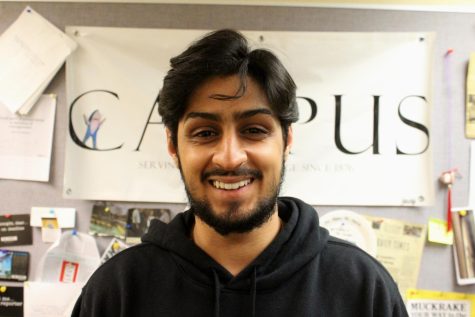WLC hosts Culture Night
The World Languages and Cultures Department
Arabic language students perform the dabke dance towards the end of the event.
The lobby of the Henderson Campus Center was decorated with colors and filled with students on Thursday, Nov. 10, as the department of world languages and cultures hosted “Culture Night.”
The event provided attendees with food and music from the different cultures represented in the WLC department — Arabic, Chinese, French, German and Spanish — and included dances and skits prepared and performed by students in WLC classes this semester.
Culture night was intended to give students in WLC classes the opportunity to showcase their learning in an experiential and creative manner, according to the Department Chair of World Languages and Culture and Associate Professor of French Briana Lewis.
“The short subtitle the department gives to the event is ‘Language Student Showcase’ because that’s exactly what the event is about,” Lewis said.
Lewis said that students in language classes were incentivized to participate in the event but it was not mandatory for them to participate.
“Many professors in (WLC) classes required students to showcase their learning in some way outside the classroom and others even offered extra credit for students who participated,” Lewis said. “Many students wanted to get involved themselves simply for the experience and the excitement of sharing your work with your peers.”
Apart from providing students with an avenue to display their learning, the event also focused on community building and spreading awareness and knowledge of other cultures.
“We are so lucky to have students from all over the country and all over the world at Allegheny,” said Assistant Professor of Arabic Reem Hilal. “Culture night is a great event to not only entertain the campus community but to also make them aware of the importance of diversity and what it means to live together in a multicultural environment.”
Professor of Spanish Barbara Riess assumed the role of master of ceremonies at the event. This was starkly different from her involvement in the inaugural Culture Night in the fall 2021 semester.
“Being up on stage gave me the opportunity to connect more deeply with the event as I got to learn the names of all the performers and even got to know some of them better,” Riess said. “It was also great to be able to connect with the audience rather than being behind the stage … it was a more vibrant and colorful experience this year.”
The event started with Riess welcoming attendees to the event and was followed by the distribution of food from stalls set up towards the center of the CC lobby.
After attendees found their chairs and settled down with their food, the first of the twelve performances started.
Students in Spanish 110, 215 and 315 compared and contrasted the differences between past and present Mariachi music by performing “Cielito Lindo” by Quirino Mendoza y Cortés and “Amor Eterno” by Rocío Dúrcal.
Next, the German department put on three performances.
First, beginner students performed a rendition of “Das Wochentage” — a children’s song used to learn days of the week. Second, intermediate students attempted animal-themed tongue twisters. Last, advanced students performed a song and dance routine from an iconic scene set in the 1920s from the 2017 Netflix drama series “Babylon Berlin” led by Gabrielle Susoiu Tcaciuc, ’23.
The French department followed with two skits. The first was a mime charade guessing game led by French Teaching Assistant Loïc Filipe-Hémery and students from French 215. The second was a skit performed by students from French 215, 305 and 360 titled, “An American in Paris.” The skit informed the audience about the difficulties one can encounter when they do not speak the local language of the place they are in.
The Chinese department provided entertainment towards the ending of the event with four song and dance performances.
Several students from Chinese 110 and 215 performed a choreographed “Square Dance” and were followed by singing and traditional dance performances by students from Chinese 305.
Quila Gustave, ’24, performed a fan dance as the final performance of the Chinese department and the penultimate performance of the culture night.
Gustave said that she choreographed the performance along with creating a costume design.
“I love dancing and I wanted to combine it with my learning in Chinese,” Gustave said. “Towards the end of the performance the crowd was getting excited and I decided to freestyle some moves to keep them going.”
After Gustave’s popular performance that merited applause and chants from the audience, the Arabic department put on a dabke dance involving students from Arabic 110, 150 and 215.
Dabke is a traditional dance from the Levant area and is particularly popular in Syria, Jordan, Palestine and Lebanon, according to Hilal.
“People do the dabke on happy occasions but people used to do the dance in the past as a test when someone would build a new house to see if it was sturdy,” Hilal said. “People would go to the roof of the new house and do the stomping style dance but now it has become an art form.”
Hilal said that the dabke is a skillful art form that is easy to participate in but difficult to master.
“We had all different skill levels amongst the seventeen students that started the dabke performance,” Hilal said. “Some of them in higher level classes performed more complex moves and we even had two students step out of the line and do individual moves.”
Ayah Sham, ’23, and Julia Sonen, ’24, were the two students who performed individually during the dabke, which was made open for the audience to join at the conclusion of the event. Much of the crowd joined the line dance including students and faculty members.
Jah’farri Brown, ’24, was amongst the students who joined in during the dabke dance.
“I loved the event,” Brown said. “I had never thought about the number of cultures in the world and the history and depth that they each have.
Lewis, Riess and Hilal all saw the event as a success and were proud of not only the student attendance but also the student involvement in the event.
“We had roughly 15 students per language participating in the event so that’s over 50 students showcasing their learning,” Lewis said.
Lewis said that the WLC department hosts two flagship events across the academic year, the Culture Night in the fall and the International Film Festival in the spring.
“During the International Film Festival, we show and hold seminars on movies from the different languages we have in our department,” Lewis said.
The film festival will occur over five weeks during the upcoming spring 2023 semester.
The idea of a Culture Night was afforded by a self-study by the WLC department in 2019 that called for making languages more visible and accessible to students on campus, according to Lewis.
“Each department has to do a self-study process every ten years to evaluate things that are going well and things that could be improved,” Lewis said. “Another idea that came from it was the introduction of an Arabic minor.”
Riess said that although the WLC department only hosts two flagship events per year, it hopes to become more involved with different student organizations on campus in order to raise awareness of the diverse cultures represented on campus.
“Collaborating with the international club was something we thought about this year and hope to make it happen next year,” Riess said.

Hassan Javed is a junior from Lahore, Pakistan. He is majoring in Communication and Media Studies while minoring in Psychology. This is his third year...









